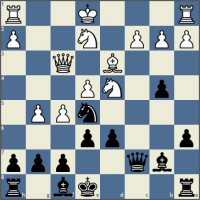
Pawn Breaks, part 3
What would you say if it was the last word you were to speak? What would you do if it was the last thing you were to do? What opening would you write about if it was your last opening column you were to write? That was a little too dramatic for a switch from the opening column to the Q+A column I guess, but our readers by now already understand that for me (Magesh) even munching on some potato chips can be dramatic!
Fortunately for us, we did not have to doddle too much on what our last opening article would be as we have one more part of pawn structures to finish. Last week we saw the advantages of using the f5 pawn break in the Sicilian defense and this week we shall continue along those lines and take a look at when the f5 break can turn out... less good for white.
In our first game today you will be able to witness how Arun clearly outclassed his lower-rated opponent using one weak square.
A very interesting middle game position just like most Sicilian defense games promise. White has parted with his dark-squared bishop in order to gain a couple of tempi with his kingside pawn storm and also to complete his development quickly. It is important in every position for us to understand our strengths and weaknesses at any point, and in this position white should be aware to protect the key e5 square using his pawn at all times. After f5, black can afford to keep a knight or even another piece right in the middle of the board in an outpost without being worried about a pawn chasing the piece away. Even if white tries to trade all the pieces that can come to e5 he will most likely be left with the light-squared bishop in the end which cannot trade on e5 leaving him with a very bad endgame.
Now let us continue with the rest of the game.
The second game we will see today is not exactly related to the f5 pawn break, but we still decided to add it as it adds a lot of value to what we are learning today. In this game I (Magesh) was defeated by the late Alexander Wojtkiewicz.
This is the reason we chose to share this game, Wojo has beautifully planted his rook right in the middle of the board. Normally we tend to see a knight sitting in such outposts, but in this case the rook does a wonderful job of protecting the e6 pawn, putting more pressure on the e4 pawn and on top of that the white knight is nowhere near to chasing the rook out of e5. This position is very similar to the type of positions that would arise when one tries the f5 pawn break at the wrong time. In the previous game we saw Arun post his knight on e5 and make sure white's light-squared bishop remains inactive throughout the game.
Now let us continue to see the end of this one.
In our last game nothing was different for me, I was white playing against Wojo in the Sicilian Defense and the result was just the same. Yes, the man did beat me anywhere and everywhere we played. He just owned me! Again a simple but effective game in understanding dark-square weakness and the resulting bad bishop situation.
We have always tried to write the ideas and strategies of chess openings in simple English words in our column rather than long and complicated chess variations which only other Grandmasters can understand. We hope that our articles have conveyed the messages the way we have always intended to and helped our readers understand the chess openings in a simple and logical way. In our opinion studying an opening requires a tremendous amount of understanding of what type of middle game it would lead to and in turn what type of end game that middle game would lead to. We are not trying to overwhelm you guys with the complexity of Chess, but just trying to steer you in the right direction on how to go about studying openings. Even if you play just one tiny little variation in a tiny little opening, just make sure you understand that well. Understand your limits and stretch yourself accordingly as trying to study many different openings when you are not well -ersed in even one will normally just lead to disaster.
Before we sign off as your opening columnists we would like to give one important piece of advice to anyone out there who is interested in improving their chess skills and is willing to work for it. Always remember, openings are only a part of the chess game, and should be treated as such. Do not over-indulge in any area for that matter. Try to focus your time and effort on all aspects of chess such as middle game, end game, tactics, analysis, time management, etc.





